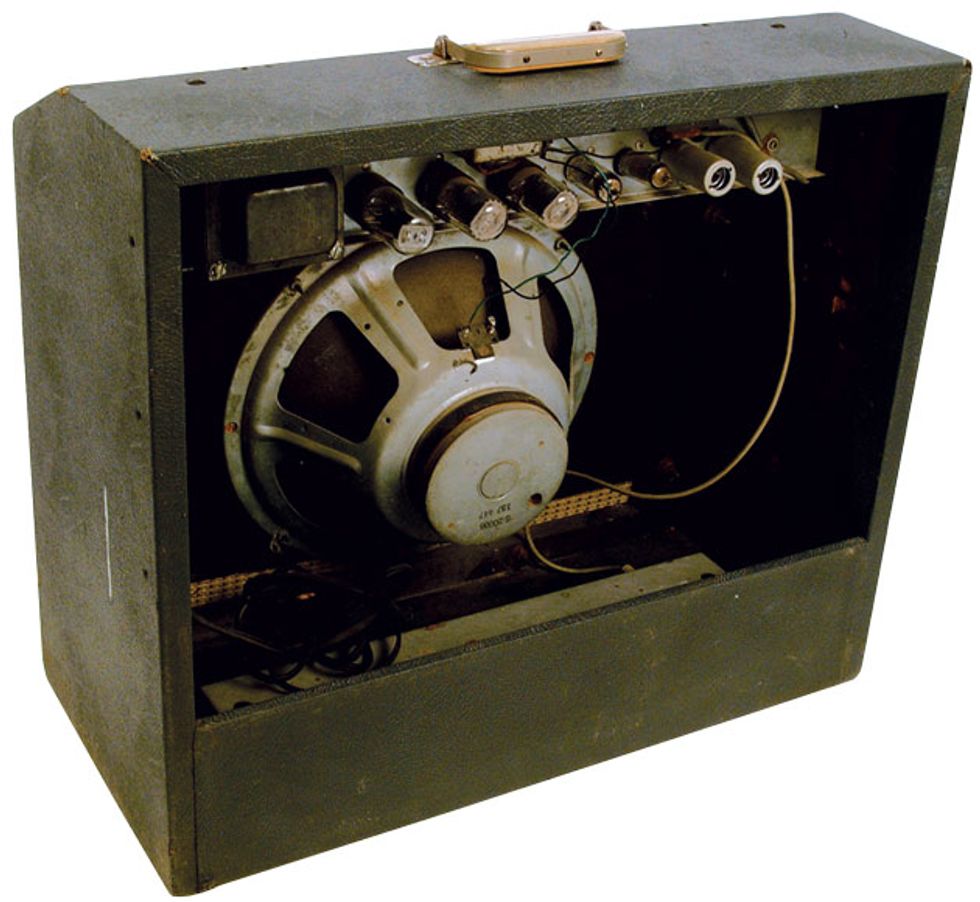Hey Zach,
I have an older Epiphone amplifier that I’d like a little background on. I bought it during college in the late 1970s and have had it ever since. It still works, but could probably use a tune-up (or whatever they do to amps to make them sound better). What can you tell me about my amp and do you know what it is worth today?
Thanks,
Christopher in Cleveland, Ohio
Hey Christopher,
I still have all the amps (and guitars) that I bought during college as well—lots of memories! I’ve touched on the history of Epiphone in earlier columns, so this month we’ll focus on the company’s amplifiers.
Epiphone began offering Hawaiian-style guitars and a line of Electar Spanish-style 6-strings in 1935, and wanted an amplifier to pair with their new guitars. Nat Daniels of Danelectro fame built the chassis for the Epiphone Electar amplifiers and a suitcase company supplied the cabinets. Epiphone produced the Electar amps through the 1930s, and in 1939 they replaced those amps with a new group of models including the Coronet, Century, Dreadnought, and Zephyr. These amps proved to be very popular and remained in Epiphone’s lineup until Gibson purchased the company in 1957.
When Gibson bought Epiphone, they continued to offer many of Epiphone’s unique guitar models, but they were less discreet about their amplifiers. Gibson discontinued all Epiphone amps and basically started rebadging existing Gibson models as Epiphones. An interesting tidbit about this era of production: Gibson generally numbered their amps in ascending order based on the price/features, so their entry-level models started at GA-5 and top-of-the-line models were numbered up to GA-400.
However, Gibson numbered Epiphone amplifiers in the reverse, meaning that the entry-level models started at EA-50 and top-of-the-line models were numbered as EA-4 and EA-5. (Most of the Gibson-branded amplifiers from this era had a corresponding Epiphone model.)
Epiphone produced the EA-28RVT in the same general configuration between 1961 and 1965, but there were two distinct cosmetic designs that help us in dating. Originally—between 1961 and 1963—this amplifier had a control panel on the top with a simple rectangular front. In 1964, Epiphone redesigned the cab so the control panel was mounted at an angle on its front, making your amplifier circa 1964/1965.
Features of the 15-watt Pathfinder include a single 12" speaker and a single channel with reverb and tremolo effects. The 7-tube chassis consists of three 6EU7 and one 6C4 preamp tubes, two 6V6 power tubes, and a 5Y3 rectifier tube. Aesthetically, the gray tolex covering and wheat-colored grille were consistent with most of Epiphone’s amplifiers at the time. There were approximately 3,026 of these amps shipped between 1961 and 1965, making the model one of their more popular and common. Meanwhile, Gibson shipped 13,914 of the corresponding Gibson GA-19RVT Falcon during the same time period.
The back end of the EA-28RVT Pathfinder reveals a single 12" speaker and 7-tube chassis design.
Gibson continued to offer both Gibson and Epiphone tube amplifiers through 1967, when they halted all amplifier production at their Kalamazoo plant. Other companies began building amplifiers for Gibson and Epiphone, including solid-state models that aren’t nearly as highly regarded. Since new ownership took the helm at Gibson in 1986, Epiphone has enjoyed success as Gibson’s budget/entry-level brand for both guitars and amps. In the mid 2000s, Epiphone introduced the Valve series of tube amplifiers that included the Valve Junior. These are extremely popular amps for modders thanks to their basic design and ease of mods. Currently Epiphone, for the most part, only offers a few budget solid-state models as part of their guitar/amp packages.
Today, a EA-28RVT Pathfinder is valued between $400 and $500 in excellent condition. Considering that its Gibson Falcon counterpart is currently worth between $500 and $650 in excellent condition, you can get the same amplifier (at least internally) for 25 to 30 percent less. It goes to show what brand recognition can do to influence value!
If your amp has been sitting for all these years, it’s a good idea to have an amp repair shop go through it to make sure it’s working like it should. Vacuum tubes wear out over time and other components can go bad as well. Spend a few bucks to get it in top-working order and you’ll ensure it’s a treasure for many years to come.

















